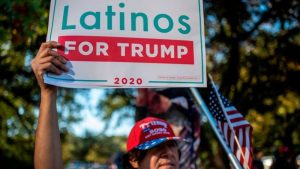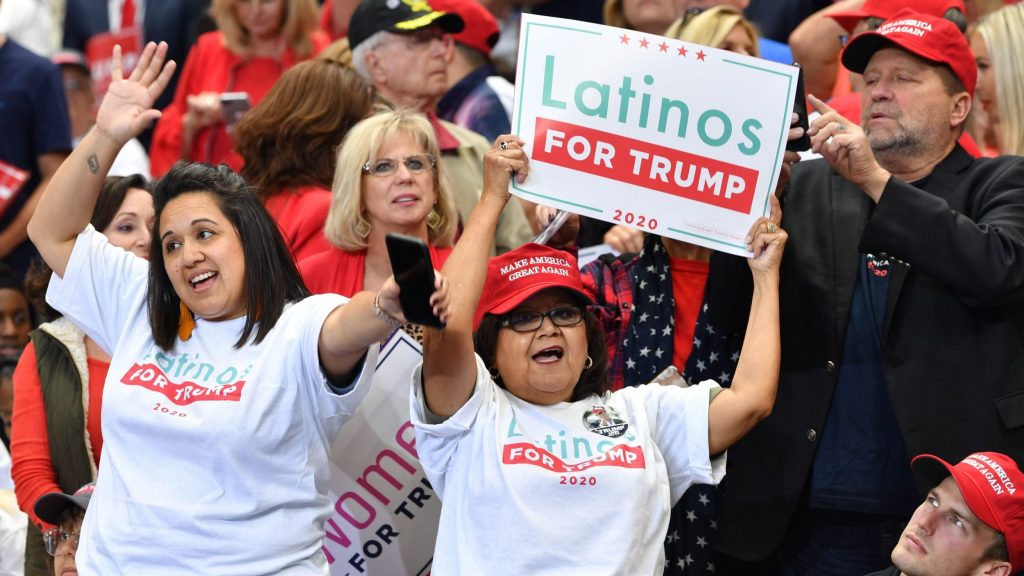In general, Americans tend to forget that the Latino community is not a monolith. It is a group of people that is diverse historically, ethnically, and culturally. Contrary to this diversity, though, historically speaking Latinos have appeared to be monolithic in their voting. When one thinks of Latinos in the political sense, they are usually considered as locked in reliable votes for the Democratic Party. However, recent elections have shown that Latinos across America are increasingly going against this expectation and voting for Republican candidates. Nowhere is this more evident than in South Texas.
With the population being almost 84% Hispanic and the region with the state’s highest concentration of Hispanics, it is expected that South Texas would be a Democratic voter stronghold.1 And it has been for many years until very recently. In the 2012 presidential election Barack Obama dominated the Rio Grande Valley by large margins, winning Hidalgo County at 70.4%, Starr County at 86.4%, Cameron County at 65.7%, and Willacy County at 71.1%.2 And although there was a slight decrease in the winning margin, Hillary Clinton still indisputably won the Rio Grande Valley, carrying Hidalgo County at 68.6%, Starr County at 79.1%, Cameron County at 64.6%, and Willacy County at 67.2%.3 However, in the 2020 presidential election the winning margins for these counties were much tighter. Joe Biden still won the Rio Grande Valley, but with significantly decreased percentages, holding Hidalgo County at 58%, Starr County at 52.1%, Cameron County at 56.1%, and Willacy County at 56%.4

What was once a sixty point blowout victory for Hillary Clinton in Starr County, is now a too close for comfort five point win for Joe Biden. Donald Trump also managed to improve in Hidalgo County by 23 points from his 2016 performance. While managing to shift each county in the Rio Grande Valley by at least 10 percentage points, Donald Trump also managed to make significant inroads with Latinos in other counties along the Mexican border. In Webb County, he improved his performance from 2016 to 2020 by 15%. Trump also became the first Republican candidate to win Zapata County in 100 years.5 Along with Donald Trump, many GOP candidates won local races for mayor, city council, and Congress in these counties along the border in South Texas. So how could this happen? How could Donald Trump, with being branded by the mainstream media as anti-Mexican/Latino/immigration (whether true or untrue), improve performance wise among Latinos in South Texas? How can a historically Democratic stronghold seemingly appear to be slipping away into the grasp of the GOP?

Well, it has to do with political strategy and political assumption. Before the 2020 census was released, demographers predicted that Texan Hispanics would become the state’s largest demographic group at 41% overtaking non-Hispanic white Texans.6 This prediction gave Democrats the belief that they would make inroads in Texas, as most Hispanic Texans vote Democratic. In order to bring out the vote and motivate their base, the Democrats developed an identity-based strategy, focusing on diversity and immigration with bilingual messaging. What the Democratic Party failed to realize, though, is that Texas Latinos in general are socially conservative. This social conservatism is especially applicable to Latinos in South Texas, many of whom are ardent defenders of gun rights, Catholic, in favor of restricting abortion, hunters, oil and gas industry workers, and supporters of law enforcement.7
With seemingly so much in common with conservative and Republican policy, then why have South Texas Latinos historically voted for Democratic candidates? Starting with John F. Kennedy’s campaign that made an effort to reach Mexican Americans, it has become culturally expected among Latinos for Latinos to vote Democrat. It has become in some ways tradition, akin to eating tamales for Christmas. This tradition is passed down from parents to children, with the Democratic Party being ingrained in their childhood.8 With this being the case, then how could the GOP make a significant dent in what was once a seemingly invincible Democratic stronghold?

Well, there is no one obvious answer. Many Republicans believe this is a long term switch and see many opportunities for potential voters. Many Democrats believe this is a one-time phenomenon, with factors such as COVID-19 affecting their ability to reach voters on the ground, the chaotic events of the year 2020, and Trump himself. It may be a combination of both beliefs, with many South Texas Latino voters claiming to no longer recognize the Democratic Party from their childhood, and believing it has gone too far-left. Because of this change in ideology, many South Texan Latinos are beginning to believe the GOP is the party they align with and is the party that will ease their concerns about the oil and gas industry, gun rights, religious beliefs, and law enforcement. In particular, during the Presidential debates Joe Biden announced his intent to abandon the fossil fuel industry, which is a large part of the economy in South Texas and offers many jobs. There was also national discussion led by the Democratic Party to defund the police, with law enforcement and the border patrol offering many jobs along the southern border. And now, onto Trump himself. Many voters felt enthusiasm about Trump, believing he finally gave them a reason to vote Republican. They also felt a sense of machismo from Trump, and viewed him as a type of luchador character that turned politics into a Mexican wrestling match, which they appreciated.9
This surprise of a turnout is forcing both political parties to rethink their strategies to garner the Latino vote, especially in South Texas. For Republicans, what was once a Democratic stronghold is now showing weakness and plenty of opportunity. To continue gaining voters in South Texas, they need to focus on emphasizing issues Latinos identity with and increase their grassroots efforts in connecting with the voters. For the Democratic Party, they need to recognize they can no longer rely on the South Texas Latino vote and to realize this group of Latinos have unique needs and concerns not found anywhere else in the country. Instead of relying on historical tradition, they need to abandon identity-based politics and offer alternative solutions to the issues facing South Texas Latino voters.
- Glenn Hegar, “The South Texas Region 2020 Regional Report,” Comptroller.Texas.Gov, 2020, https://comptroller.texas.gov/economy/economic-data/regions/2020/south.php. ↵
- John Schwartz, “Texas State Highlights,” The New York Times, 2012,https://www.nytimes.com/elections/2012/results/states/texas.html. ↵
- “2016 Texas Presidential Election Results,” Politico, 12-13-16, https://www.politico.com/2016-election/results/map/president/texas/. ↵
- “Texas Election Results 2020,” NBC News, 4-15-20, https://www.nbcnews.com/politics/2020-elections/texas-results. ↵
- Jack Herrera, “Why Democrats are Losing Texas Latinos,” Texas Monthly, October 2021, https://www.texasmonthly.com/news-politics/democrats-losing-texas-latinos-trump/. ↵
- Alex Ura, Jason Kao, Carla Astudillo and Chris Essig, “Redistricting Texas,” The Texas Tribune, 8-12-21, https://www.texastribune.org/2021/08/12/texas-2020-census/. ↵
- Jack Herrera, “Why Democrats are Losing Texas Latinos,” Texas Monthly, October 2021, https://www.texasmonthly.com/news-politics/democrats-losing-texas-latinos-trump/. ↵
- Mitchell Ferman, “Texas 2020 Elections,” The Texas Tribune, 11-13-20, https://www.texastribune.org/2020/11/13/south-texas-voters-donald-trump/. ↵
- Alexandra Villarreal, “Why Democrats Lost Latino Voters Along Texas Border,” The Guardian, 11-7-20, https://www.theguardian.com/us-news/2020/nov/07/how-democrats-latino-voters-texas-border-towns. ↵



22 comments
Steven Valdez
This was a very fascinating article to read. I have many family members who are conservatives. I have always wondered why all of a sudden Latinos were switching over to the Republican party. This article provided a very clear and perfect explanation. Everything you said on why they believe in things like anti-abortion laws, and religion were exactly on point. I see debates about this all the time with my family. Everyone has their own opinions and I can respect that. Again, this provided a very clear explanation for me, so thank you.
Esteban Serrano
Hi Mason,
Great work on the article, bud. It’s a very interesting topic because of the demographics of voters in the current term. I see this too in everyday life. As you mentioned- fracking jobs are being lost and some feel many things are necessary because of a high percentage of Latinos and Hispanics being Catholic has a lot to do with issues such as abortion. Many simply like how he is ruthless in his speech unlike other administrations’ presidents in the past that are careful on what they say. It’s a very complicated idea, but also a psychological one. It’s not just here, but in other ethnic groups such as those who identify as African-American. There are some who support Trump, but the number is of course lower due to his responses to say the George Floyd or Breanna Taylor tragedies. Psychologically, like the rest of America, registered voters have a choice, and a lot of it is really who is the better candidate to a lot of people.
Emily Rodriguez
Hi Mason,
Thank you for writing such an intriguing article. I had begun to notice that recently, the Latinos have been turning more to the right but I was unaware of some of the factors that have played into account. One thing I did know that aligned with your article, was the uproar from a lot of people with Biden announcing his plan to abandon the fossil fuel industry. I think it just goes to show that candidates shouldn’t rely on certain demographics always voting their way. I liked how you included the drops in percentages with the statistics; It gives the reader a better representation of the decline of democratic voting in different areas.
Eugenio Gonzalez
As a Latino and Political science student deciding to read your article was an easy choice for me. I enjoyed your article because it explains why Latinos in South Texas are aligning themself with the Republican party. Another insight that I take from reading your article is how political parties evolve and how it affects the political landscape. An example of that would be how the evolution of the Democrat Party has caused many Latinos to no longer feel aligned with the Democrat Party. I think that these changes in the voting behavior of Latinos in South Texas represent what might happen in the future with the shift in the voting behavior of many regions.
Rafael Portillo
Thank you for giving me the chance to read such an insightful article. Politics has always been an issue for many generations and maybe even worse now. Everyone has to be careful of what they say, post, believe etc. I on the contrary believe that we all have the right to our opinions even if they don’t match or agree with others. This article was very well written and being an Hispanic from a republican family I can agree with everything that was said here.
Ana Barrientos
I personally chose to read this article because as someone who is a part of the Latino community I definitely see more and more Latino people choosing to go conservative. I have family and family friends who are very conservative. Everything you said in the article about them being very religious, anti-abortion, and supporting law-enforcement is 100% true. I see it all the time on my Facebook feed. I personally am a Democratic Latina so this article was definitely very informative and very interesting to read.
Victorianna Mejia
I loved this article so much! As a Latina raised on the border, I witnessed the shift from the democratic vote to the republican growing up. I genuinely believe that COVID is to be blamed for the second major shift of voters. I also believe that the “machismo” that Trump gave off influenced many male Latino voters. I also find it a little hilarious because the older generations of my family are democrats, but the younger generations usually are republicans.
Kensley Dieckow
I really enjoyed reading your article. Your research into specific elections where shift began was very interesting. This article shows that people of all races vote based on issues that are important to them individually. To me personally my vote depends on who the specific candidates are and their plan for office. Its interesting that more and more people are starting to think that way too.
Sarah Rodriguez Rodriguez
I was interested in reading this article from experience living in Texas and being Hispanic. It’s definitely interesting how many more Hispanics are turning to the Republican Party and claim that the Democratic party has gone too far left. I know a lot of Hispanics are very conservative religious people, so it makes sense that some have stepped away from the Democratic party and joined the Republican party that’s becoming more conservative than ever. While I don’t believe this is a one-time phenomenon, I also think that this won’t last as times change and people are getting educated.
Anissa Navarro
I chose to read this article because like in your article I come from a border city in Texas. However, I come from a democratic city and I have noticed no change in my cities political beliefs. I was not aware there were so many border city Texas latinos who had a change in political belief. I do agree political beliefs are ingrained in children minds like you said but that goes for all parties. There was some choice of words I did not agree with but your article was informative in a way.